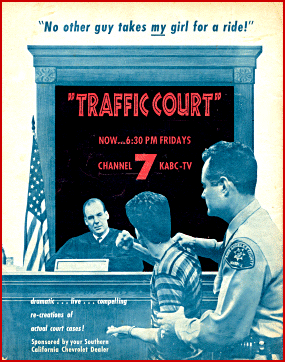
Ad
in TV-Radio Life noted, at the bottom, that the show was "[s]ponsored
by your Southern California Chevrolet Dealer."
Thursday, April 10, 2003
Page 15
REMINISCING (Column)
‘Traffic Court’ Gains a Sponsor; Judge Younger Obliged to Quit
By ROGER M. GRACE
Cameras were barred from Los Angeles courtrooms (and those statewide, and most everywhere in the United States) in the 1950s. Except for taking time off during the day to attend a court session, there was only one way a person in these parts could get a glimpse of how cases were handled: watching “Traffic Court.” And that’s something a lot of local viewers did. Launched by KABC-TV, Channel 7, in 1957 as a public service show, it became an unexpected winner in the ratings, drawing an audience of nearly three-quarters of a million people.
Unlike shows like “Perry Mason,” it was plotless and unscripted, at least in the sense of there being prescribed dialogue. Fact situations were derived from actual traffic citations, but the actors, portraying the defendants, and the judge—Evelle J. Younger, a real-life member of the Los Angeles Municipal Court—would wing it. Through these faithful facsimiles of judicial proceedings, viewers learned something about court procedures and Vehicle Code provisions. But aside from that, they found the show entertaining.
Here are descriptions of a couple of the shows, as they appeared in listings of TV-Radio Life:
Oct. 18, 1957: “A 24-year-old transient is arraigned on charges of speeding through downtown L.A. on the wrong side of the street, running four red lights, and trying to run down two officers who tried to apprehend him. Drunk driving charges? Yes, that, too. A young girl is charged with stunt driving on a motorcycle, and a man charged with carrying five phony drivers’ licenses.”
Dec. 13, 1957: “A ‘speeding’ cement mixer, a bad check passer, and a weekend bicyclist figure in cases aired before Judge Younger tonight. Test case: can a Christmas truck be stopped by police on its appointed rounds?”
“It was quite successful,” retired Los Angeles Superior Court Judge Eric E. Younger says of the program presided over by his late father. “That’s why Chevy picked it up.”
When the Southern California Chevrolet Dealer Assn. assumed sponsorship of the show, its status as a “public service” program fell into question.
|
|
|
“Somebody complained that it was not appropriate for a sitting judge to be on a commercially sponsored television program,” Eric Younger recounted.
Evelle Younger, unlike Dinah Shore, was not called upon to blow a kiss to the audience at the end of the show and launch into a chorus of “See the U.S.A. in your Chevrolet.” Nor did he turn to the camera after a defendant presented his or her case and announce: “I’ll bring you my verdict in a moment. But first, friends, let’s talk about the sleek looks of the 1958 Chevy Impala.”
Nonetheless, Younger submitted an inquiry to the Ethics Committee of the Conference of California Judges (now known as the California Judges Assn.). As Eric Younger tells it:
“The Ethics Committee said, ‘Nah, we don’t like the looks of it,’ so he quit [the show].”
(The Committee on Judicial Ethics invoked Canon 2B(2) which provided—and still does—that “[a] judge shall not lend the prestige of judicial office to advance the pecuniary or personal interests of the judge or others.” Its Jan. 11, 1958 opinion said that “the judge’s participation in the television show ‘Traffic Court’ is such that inevitably justifies a reasonable suspicion that the power and the prestige of the judicial office is being used to promote a commercial product.”)
That was, of course, not the last that was heard of Evelle Younger. In the Nov. 4, 1958 election, Younger performed the extraordinary feat of toppling an incumbent in a Los Angeles Superior Court race. Although Younger did have a campaign issue—the judge was 88— name recognition from having presided over the TV “Traffic Court” could not have hurt.
For whatever reason, the thumbnail biographies Younger used in his successful campaigns for district attorney and attorney general, and in his ill-fated effort to wrest the governorship from Jerry Brown, made no mention of his role on “Traffic Court” or his 1948-49 hosting of “Armchair Detective.”
There will be more about “Traffic Court” and other simulations of courtroom proceedings—some striving for accuracy and some merely for ratings—in future columns.
Copyright 2003, Metropolitan News Company